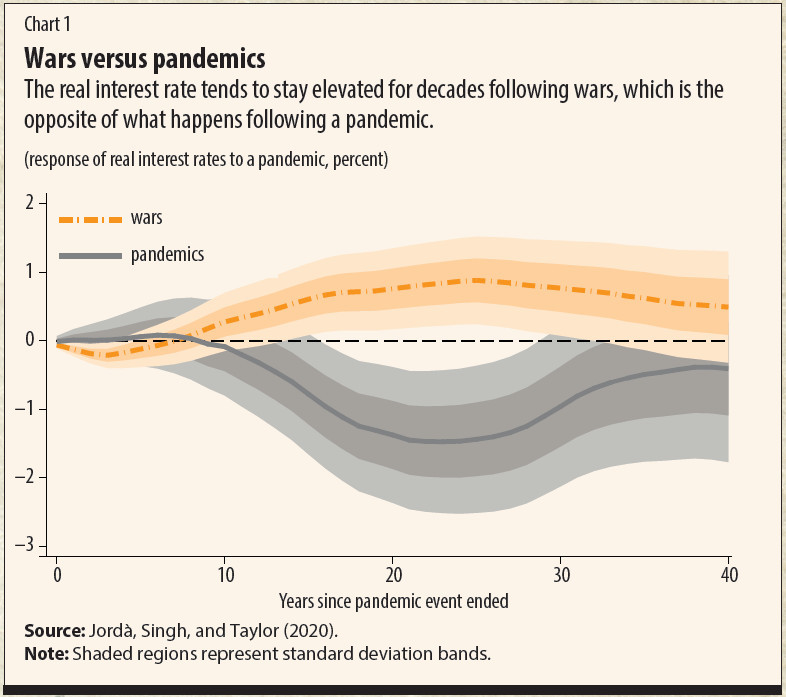 Dear Colleague,
In our latest issue of F&D, which focuses on economic policymaking and politics in light of the pandemic, Òscar Jordà, Sanjay R. Singh, and Alan M. Taylor of UC Davis write that COVID-19's toll on economic activity in recent months is only the beginning of the story. While the rapid and unprecedented collapse of production, trade, and employment may be reversed as the pandemic eases, historical data suggest that long-term economic consequences could persist for a generation or more.
Among these are a prolonged period of depressed real interest rates—akin to secular stagnation—that may linger for two decades or more. Still, one piece of good news is that these sustained periods of low borrowing costs are associated with higher real wages and create ample room for governments to finance stimulus measures to counteract economic damage caused by the pandemic.
A look at previous pandemics, going back to the Black Death in the 1300s, can help fill this gap by shedding light on their medium- to long-term economic effects. In extrapolating from historical trends, though, it’s important to note one crucial distinction. Past pandemics such as the Black Death occurred at times when virtually no one survived to old age. With today’s longer life spans, perhaps this time may be different: COVID-19 mortality appears to disproportionately affect the elderly, who typically no longer participate in the labor force and tend to save more than the young.
Digging deeper, a new paper by Jordà, Singh, and Taylor takes a global view of the macroeconomic consequences of pandemics across a number of European economies—focusing on the aftermath of 15 large pandemic events with at least 100,000 deaths. Using newly available data on yields of long-term sovereign debt stretching back to the 14th century, they estimate the response of a so-called real (after-inflation) natural rate of interest in Europe following a major pandemic.
Economists speak of the natural, or neutral, rate of interest as the equilibrium level that would keep the economy growing at its potential rate with stable inflation. In the long run, the relative demand and supply of loanable funds by savers and borrowers determine the natural rate—an important economic barometer. For example, as populations become more frugal, the relative supply of savings increases; when the underlying pace of growth wanes, investment becomes less attractive. In both cases, the natural rate declines to restore equilibrium.
 As shown in Chart 1 above, pandemics have long-lasting effects on interest rates. Following a pandemic, the response of the natural rate of interest is tilted down by nearly 1.5 percentage points about 20 years later. For perspective, that decline is comparable to what we have experienced from the mid-1980s to today. We also find that it takes an additional 20 years for the natural rate to return to its original level.
Interested in learning more? Take a 5-minute break and read the full 1200-word article. If you prefer to download the PDF, click here.
YOUR QUESTIONS, ANSWERED.
At the end of last Tuesday's newsletter, we asked F&D readers to send in any questions they had on political economy for Harvard professor of government Jeffry Frieden, who authored an article on the political economy of economic policy for our summer 2020 issue of F&D.
We received many questions from across sectors and around the world, so thank you very much for your interest. Professor Frieden took 15 minutes to respond to individuals from Guyana, India and the Netherlands:
- How do we coordinate a global response to COVID-19? Watch response.
- What can we do to improve international cooperation around standards, such as carbon emissions? Watch response.
- How should policymakers be thinking about politics and economics—which one causes the other? Watch response.
- If policymakers focusing on the next election failed to prepare us for this long overdue pandemic, one would expect less democratic forms of government to be better at strategic anticipation of long-term threats such as these. Was that the case? Watch response.
Would you like more opportunities to ask the author of F&D articles? Do you have other ideas for how best we can further the conversation on important issues? Please do write me a note. Any and all feedback welcome. I would love to hear from you.
Take good care,
|